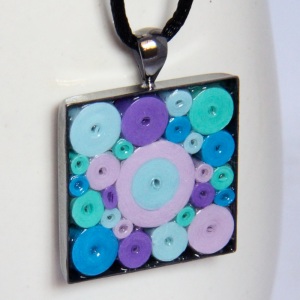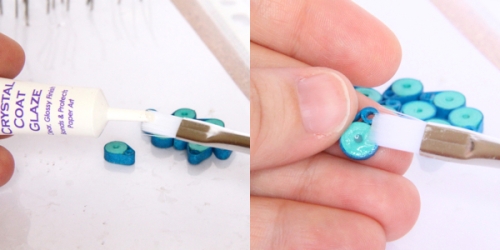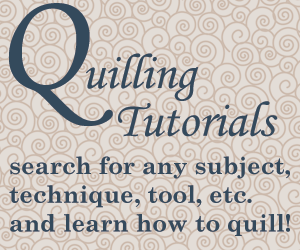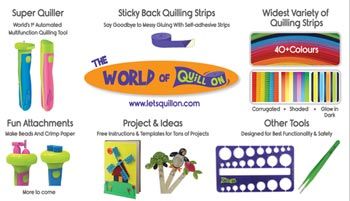The most frequently asked question I get is how I make my paper quilled jewelry water resistant. What sealant do I use? Which is best? How do I apply it? Well, it’s about time I show how and what I use so that it’ll be easy for me to direct anyone toward this post instead of typing out an answer each time. Plus this includes pictures, which are always helpful!
The most basic answer I can give is that you can most likely use any sealant that you can get at your local craft store. But do be sure to read the directions, as some are made specifically for paper and some are not. Also some are water resistant, some are water proof (rare!), and some just give some sturdiness but are not really water resistant. Think about what type of coverage you want, read the bottle carefully, and go from there.
Having said that, I also want to share which products I use, how I use them, and why.
First up, PPA (Perfect Paper Adhesive). PPA is a glue, a sealant, and a topcoat. It provides a very water resistant layer to your paper quilling. PPA is my absolute favorite glue for paper quilling, click HERE to read my blogpost about quilling glues to see why! But it is also great as a sealant.
To use as a sealant, either dip your brush into some PPA or squeeze some PPA onto your brush from your glue bottle. Paint the PPA onto your quilling piece on one side. You will notice that it is white looking. But don’t worry, it dries perfectly clear and also soaks into the paper, so it won’t leave clumps. When one side has dried, you can flip it over and do the same to the other side. When the second side has dried, put another layer on, this time dabbing your brush into all the crooks and crannies to cover all surfaces. The better you cover your surfaces, the more sturdy and water resistant your piece will be. In these photos I used PPA to seal this butterfly earring:
Another nice feature of PPA is that it comes in matte or gloss
. The matte has a very matte finish, nice for when you don’t want your paper quilling to look shiny at all, but still want that sturdy and water resistant finish. When you use PPA as a sealant, the color of your paper will stay exactly the same, nice when you don’t want to risk a sealer that may change the shade of your paper. The gloss is a very nice shiny look.
Next up, liquid matte sealant – this is the sealant that I most commonly use for my paper quilled jewelry because it works very well and is also one of the first ones I ever tried.
**UPDATE** This sealant can be found here in Malaysia, but if you are in the US, check out Ceramcoat All Purpose Sealer, which I now use and works the same. Click here to read a full review post about the Ceramcoat All Purpose Sealer.
It comes in a little jar with a flip top lid (like in the photo above, not in the photos below) . It is called matte sealer, but if you use several layers your finished piece will have a bit of a shine (but not as shiny as a gloss finish sealant). If you just use one layer it will be matte. This sealant is very useful for many crafts! I’ve often painted it over paper mache that has been painted with poster paints which helps seal the paint so it doesn’t chip and also makes it water resistant. But of course I mostly use it for paper quilling!
To use all you do is dip your brush into it and paint it onto your piece. For most quilling you’ll want to paint one side, let it dry, paint the other side and let it dry, and lastly paint all the crevices and let it dry. The reason you want to do one side at a time and then the crevices is that if you put too much sealant on all at once your piece can get soggy and out of shape. By using several layers (allowing it to dry between layers) it prevents this from happening. This sealant is white, but it quickly soaks in and dries to a clear matte finish. Because this sealant is liquid you could also pour it into a small spray bottle and spray it onto your pieces. I did this for a long time, but now I prefer the painting method because it doesn’t waste some of the sealant. But if you are doing a large surface area, then the spraying method works great! For solid pieces of quilling you can also just dip the piece into the sealant, dab off the excess with a tissue, and lay to dry on a plastic surface. Click here to read a post all about making sure that your coils don’t open up when you put on sealant.
When you use this liquid matte sealer on your paper quilling you will notice that it makes the shade of your paper just a TINY bit darker. I have not found this to be a problem at all, but just wanted to point it out. When the sealer soaks into the paper you can see the color difference. Also, if you want to make sure your piece is water resistant you definitely want to do at least two complete coats of this sealant. Because it soaks into the paper so much, sometimes one layer is just not enough. Your piece will still be sturdy and mostly water resistant, but there is definitely a better result with at least two complete layers. You will notice as you put on the second layer that it does not soak in as quickly as the first layer.
**UPDATE** To make sure that your piece is very water resistant, it is BEST to put on a topcoat on top of the sealant after it is completely dry. You can use the PPA, Crystal Coat Glaze, Diamond Glaze, 3D Crystal Lacquer, or others. If you do not put a topcoat over the sealer, the sealer can kind of wear off over time. It is awesome for stiffening up your quilling and I almost always use it, but I either use many layers, or usually put a topcoat on top of it.
The third type of sealant I use is Crystal Coat Glaze (find it here at Custom Quilling or here on Amazon). It gives a clear glossy finish! This is my favorite sealant to use when I make pieces that are inset such as this one below. Just glue your pieces into the inset pendant base (use the crystal coat glaze as your glue as well) and then squeeze a layer of crystal coat glaze over the whole thing. It will appear to look 3D and a cloudy color, but will flatten out as it dries to fill in all the crevices and be clear, shiny, and hard! Allow to dry for at least a couple days for a hard finish, at least in a tropical climate like it is here! If you use the crystal coat glaze for this purpose, one tube will usually last between 2-4 pendants (each pack comes with three bottles). *it now comes in either a three pack of little tubes or a new 2 oz. bottle! You could also use PPA glossy for this purpose.
Here I am using crystal coat glaze as a topcoat for these quilled pieces. They have already been dipped into the liquid matte sealant and left to dry. But I wanted to give a final coat that was glossy. I just squeeze a bit of the glaze onto my paintbrush and paint it onto one side of the piece. After it dries I’ll do the other side and then the sides. I also often put my earrings onto their earring hooks, then add the crystal coat glaze to all sides at once and hang to dry on my earring rack.
Instead of painting the glaze on you can also just squeeze it on. This has a nice effect because it gives a bit of a thicker coat. You can hold it in your hand to do this, or lay it on a plastic surface. Make sure one side is completely dry before doing the second side! You can use crystal coat glaze as your only sealant, but I usually use it on top of the liquid matte sealer so that I don’t have to use as much crystal coat glaze, unless I am using it for an inset pendant as seen above. The reason I do this is that it is a bit more expensive than the other options and works just as well if just used as a topcoat over another sealant.
So there are three of the types of sealant that I currently use. With any of them, make sure you rinse your paintbrush completely immediately after using the sealants so they don’t dry onto your brush. If they do dry onto your brush, just soak in soapy hot water to try and get off as much as the sealant as you can, but you may have to replace your brush anyway. I wrote another article with more sealants that show the different effects of each one. Click here to read that article!
I get a lot of questions about water resistant vs waterproof. I don’t know any product that claims to be 100% waterproof unless you want to dip your final pieces into resin or something like that (which I have done and is another option if you like to play around with resin, but that’s for another post). But all of these sealants will give a great, very water resistant seal. This means that you don’t have to worry about being caught in the rain. You don’t even have to worry if your piece gets spilled on or accidentally drops into a liquid. However, prolonged exposure to water is still not a good idea. For example, you will not want to leave a piece in your pants pocket and let it go through the washing machine! You will also want to remove it before bathing or swimming. Though if you realize halfway through your shower that you are still wearing your paper quilled earrings you can still remove them and lay them out to dry and they will most likely be perfectly fine! (I’ve done that a couple times)
Whew, that was a lot to read I’m sure! If you have any other questions about using sealant for your paper quilling, let me know in the comments below and I’ll add the answers to this post or make a follow up post.
**UPDATE** – Since writing this article, I have written many more about specific sealants and topcoats that I have used. Click here to read them all!
Click HERE to view many more tips and tricks for paper quilling, divided into subjects!
Click HERE to view free tutorials for paper quilling projects!
Click HERE to find where you can purchase paper quilling supplies – many sources listed from around the globe!
http://www.honeysquilling.com/sealants-for-paper-quilling-how-some-different-sealants-look/
*This post contains some affiliate links. If you make a purchase through the affiliate link I get a small percentage. I only link to products that I use and love. Thank you for supporting my blog!































What craft store do I go and get the glue from thank u again for breaking down the steps it was very helpful
Hi Francine. I am not sure which country you are in, but you can check any local craft store, or you can order online.
Good information is given.thank you for sharing this..I have one question when i have applied sealent on small teardrop,it became inside shape was ruined…it beame like i m qlueing inside part…please reply what to do when applying sealent to delicate jewelery.
Thank u
Hi Marich,
Yes, when applying sealant you must be careful so that the shape of the coil doesn’t get ruined! To do this, apply it slowly and let it dry in between layers. Apply just a little bit on one side, let it dry, apply a little bit on the other side and let it dry, and then apply more on each side and let it dry. Finally get into all the crevices you may have missed and let it dry yet again. I will put up a tutorial soon especially for this!
thank you
Please advise the link to buy glossy sealant for paper jewellery. Thanks a lot.
Hi Nisha 🙂 There are several glossy sealants you can use for paper jewelry. You can use crystal coat glaze, glossy topcoat, or PPA glossy just to name a few. Click on each name here to go to the link to the product in my shop 🙂
Hi ,
This post is very help full i tried to buy liquid matte sealant in USA i am not able to find it.
Can you please help me where can i get it.
Thanks
Hi,
The liquid matte sealant is only sold here in Malaysia that I know of. I plan to test some products in the US to see if they work in a similar way. I haven’t tried yet, but I plan on trying things like fabric stiffeners (there are several brands available on Amazon). They are liquid and soak in, so they might work similarly. I will get around to trying some and posting about it, but it won’t be for a few months probably. If you have some fabric stiffener, give that a try, or pick some up on Amazon or a local craft store 🙂
Good information is given.thank you for sharing this..I have one question
can i use fevicol and water for this
Hi 🙂 I know that a lot of quillers in India use fevicol for sealing. I haven’t seen it for sale here in Malaysia so I haven’t personally tried it. But I know a lot of people have, and like it, so give it a try! Some people do say they prefer other sealants, so give it a try and see whether you like it or not 🙂
hi,
ive been quilling for a while now……..but i have a question, can i use a transparent nail polish to make it water resistant?
Hi 🙂 Yes, you sure can and some people do. I don’t for a couple reasons. Firstly, I don’t like that it is toxic, fumey, and smelly. Secondly, nail polish is not formulated to be long lasting. Meaning over the months and years it could crack and turn yellowish. It might not, but it may, there is no guarantee. So for these reasons I don’t use it. But you can use it if you wish!
Thnkz…dis info ws quite useful….can v use fevicol or transparent nail enamel too…?
I know many quillers in India use fevicol, so give it a try and see if you like it. I know some people use transparent nail enamel as well. I have at least 3 reasons why I don’t use the clear nail polish. 1) it’d get pricey 2) it’s not non toxic, it has stinky fumes 3) it’s not meant to last forever, so it can get a yellow tint over time
HI,I TRIED USING FEVICOL BUT INSTEAD THE JEWLLERY TURNS BLACK WHAT ELSE CAN I USE.BUT I HAVE A VERY LOW BUDGET SO CAN YOU HELP ME OUT.
THANKS AND REGARDS
ANIRUDH
INDIA
Hi 🙂 I haven’t tried fevicol yet, but I know many people use it and like it. Was it the actual paper that turned black or was it the jump ring/earring hook? I know many use mod podge as well which you should be able to find in India, though it’s more expensive than fevicol. But a little goes a long way and you’ll find a bottle of sealant lasts you for a long time. If you are selling your jewelry it’s best to invest in a proper sealant, just make sure to price accordingly so you can afford to use it. If you are doing it for your own use then perhaps experiment with the varieties of fevicol, or with wood varnish if you wish (I don’t like using wood varnish myself as it has fumes and is toxic, but others use it with success).
Hi Honey! I m from India. I have mod pudge product. But I am not able to understand what it can be used for in case of paper quilling? Also what is order in the procedure of quilling- make quilling, painting, stickers, beads stick, varnish…..? Would be so grateful if you could help me out?
Hi 🙂 I haven’t used mod podge yet, but I recently bought some. Once I try it out a bit I’ll post some tutorials and tips for it. But as far as I know it can be used as a sealant and topcoat for paper quilled jewelry. WHen making paper quilled jewelry I don’t use painting or stickers or beads, but if I were going to, I’d first use a sealant, then do the paint and stickers, then do a topcoat, and lastly glue on beads.
sis…where i can get that PPA glue in Malaysia…
can u give me a specific place so i can buy from there…
Hi 🙂 The only place I know of to buy PPA in Malaysia is my online shop http://HoneysQuillingShop.com
Can I use mod podge matte as sealant???
I know some people do. I have bought some to try out so I can give my opinion as well, but haven’t had a chance to test it yet. It’s on my list to start soon! In the meantime, if you have some mod podge around, go ahead and give it a try, because I know some people DO use it as a sealant for their quilling.
Hi Honey!
I was wondering if you can tell me more about resin coating. I have tried the PPA glossy and love it but am wondering if I should dabble in other options. I have come across ICE Resin, Envirotex Jewelry Resin, and EasyCast Epoxy. Do you have experience with any of these? I would love to hear what you think. Thank you!
Marissa
Hi Marissa – one of these days I’ll do a post about resin coating! I have used resin in the past, but not recently. The resin I used was a two part resin. It wasn’t any particular brand, I bought it from a local craft shop here in Malaysia. I liked that it gives a very sturdy and thick plastic coating, so your final piece is definitely water proof! The thing you most have to be careful of is that your piece has to be COMPLETELY sealed before either pouring on or dipping into the resin. This is because if the paper is not sealed, the resin will soak into it and it makes it a much darker color, it really doesn’t look nice when it has darker splotches here and there from not being sealed properly. Resin also usually has fumes, so you have to do it outside. I found it more useful to set up a table and do quite a few pieces at once, since you have to mix together a certain amount and use it all up or else it’ll harden and be of no use. So it’s not as user friendly as something like PPA which you can use whenever you need to and for however many pieces you need to. I’d look up some reviews of the resins you mentioned and choose one with the best reviews. Some are easier to use than others. Some will turn yellowish after some time (the one I was using turned a little yellowish, only noticeable on the white colored jewelry). Some of them are more toxic than others. I have one more type of resin to try and I will be posting about that, but that probably won’t be for a few months, I have a lot of things to catch up on here and to test out!
Hi Honey’s Quilling
Can PVA Glue be used as a sealant instead? I am trying to make a quilled keyring for Mothers’ Day and I don’t have any sealant at home!
Thanks 😀
~Sascha
P.S. Check out my blog at crafty.laingstraits.com
Hi Sascha. Normal PVA glue does not usually make a good sealant. Depending on the brand, it is sometimes not perfectly clear when dey, instead it is a little bit cloudy/blur. Also if it gets wet it is not as water resistant. It can get white spots on it if it gets wet. It can work in a pinch if you have nothing else and if you don’t care about it being perfect, but a proper sealant is definitely better.
Comment can we use varnish to the quilled earings shinning…
Hi Vidhya, there are so many kinds of varnish, so it is hard to say just “yes” or “no” 🙂 Have a look at what is available near you, and give it a try. That is the best way to know. If the container says it is good for paper, then that will be best. There are some varnishes that are made for wood. Those can work, but they can also be very smelly, so make sure to use them in a ventilated area.
Hello,
Thank you for all the information.I just wanted to ask you what happens if we directly apply a coat of crystal coat glaze?
That will work just fine, your finished piece will be a bit flexible, but still water resistant. With the liquid sealant first it stiffens the paper, making it more sturdy. But it’s optional
I really enjoy your blog. I have gotten a lot of useful information from you. I tried to go to the site with more information about sealants, but it was not available. Can I use a spray gloss for jewelry? I plan on trying it, but wondered if you had any comments.
Hi 🙂 I have a blog post here about using spray selants: http://www.honeysquilling.com/using-spray-acrylic-sealant-or-lacquer-for-paper-quilled-jewelry/
Basically, you can, but there are times when it is not as useful as a liquid paint on one. You can read the post to see all of my reasons. I personally tried it a few times, but gave up and don’t bother with it for jewelry anymore.
For paper craft also is it good … to percent for dust n alll … pls tell me .. thanks
Hi Husnaa, I’m going to guess that you’re asking whether it is good to protect your paper crafts from dust. It depends on what you are making. If it is something that will be exposed to dust, like some decoration on the outside of a frame, or a fridge magnet, decoration on a jewelry box, etc. then it can be a good idea to use sealant to protect it. It doesn’t necessarily need it, but it will protect it from getting bent up when you dust it (you can use a feather duster to dust it). The sealant will not protect your craft from getting dust on it, but it will make it easier for you to get the dust off of it, if that makes sense.
Hai
I’m from India. I’m new to Quilling. I have gotten a lot of useful information from your blog. But i was totally confused what type of sealant should be used to make quilling jewelry water resistant and to get neat finishing. Please help me..
Thanks..
Hi 🙂 there are so many sealants that you can use. Here are all the posts I have so far about sealants: http://www.honeysquilling.com/sealants-for-paper-quilling/
I know a lot of quillers in India use fevicol as their sealant, and some put clear nail polish on top of that or a wood varnish. I don’t use varnish myself since it is stinky.
You can also get mod Podge and PPA in India in some places. One of my other favorites is Diamond Glaze, but I don’t know if you can find that everywhere in India.
hi honey,
i recently taken interest in paper quilling, im a single mom from the philippines and I need an extra source of income plus I am a frustrated artist, they said it’s never too late to follow your passion. Your blog will be my go to bestfriend once I started this quilling project anytime soon, I hope you don’t mind 🙂 thank you! i’ll be seeing more of you soon!
Hello, all of this information is wonderful, thank you so much for writing it. I have decided to get some PPA for a sealant but I cannot decide between matte and gloss finish. The paper I will be using is a metallic gold, would the matte PPA dull the shimmer? Which would you use? I am making chess pieces rather than something very delicate. Thank you for your time and efforts.
Hi Katherine! Thanks for your comment. I would go with the gloss. The matte will definitely dull the metallic finish of the paper! It is perfect for other papers when you don’t want your finish to be shiny, but for metallics the gloss is definitely the way to go!
Thank you so much for your quick reply. Gloss it is!
Hi there, I am confused on which sealant is best for canvases, can you please advise me on which of these two is better.
– Krylon Acrylic Crystal Clear Aerosol
– Krylon Clear Matte Sealer Aerosol
Thanks
Hi Akruthi,
Between those two sealants, either would work for canvas, it’s just your choice whether you want your finished work to be shiny or not